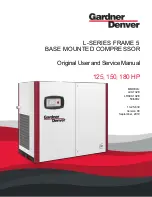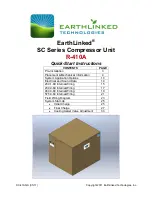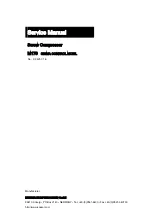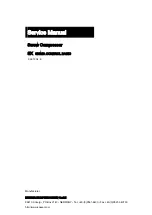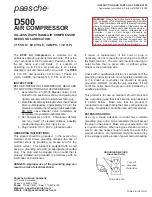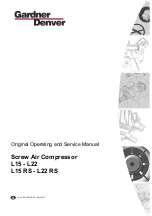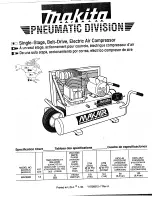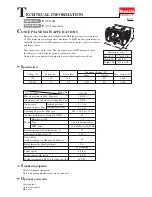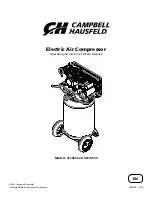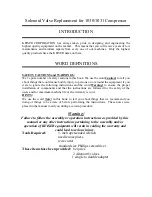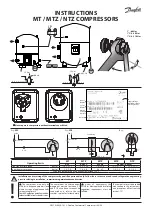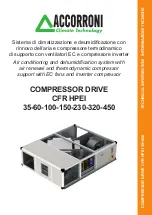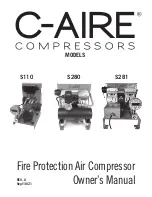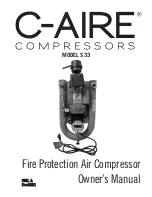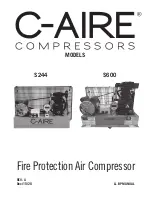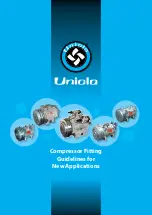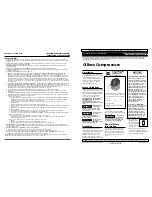
Instructions
4 | AN309640488445en-000201 - 8510290P02B
© Danfoss | DCS (CC) | 2020.10
5 – Handling and storage
•
Handle the compressor with care. Use the
dedicated handles in the packaging. Use the
compressor lifting lug and use appropriate and
safe lifting equipment.
•
Store and transport the compressor in an
upright position.
• Store the compressor between Ts min and Ts
max values for LP side indicated on compressor
nameplate.
•
Don’t expose the compressor and the
packaging to rain or corrosive atmosphere.
6 – Safety measures before assembly
Never use the compressor in a flammable
atmosphere.
• Check before assembly that the compressor
does not show any obvious signs of
deterioration that could have occurred during
inappropriate transportation, handling or
storage.
• The compressor ambient temperature may not
exceed Ts max value for LP side indicated on
compressor nameplate during off-cycle.
•
Mount the compressor on a horizontal flat
surface with less than 3° slope.
• Verify that the power supply corresponds to
the compressor motor characteristics (see
nameplate).
• Use clean and dehydrated refrigeration-grade
copper tubes and silver alloy brazing material.
• Use clean and dehydrated system components.
• The piping connected to the compressor must be
flexible in 3 dimensions to dampen vibrations.
7 – Assembly
• The compressor must be mounted on rails or
chassis according to Danfoss recommendations
described in related product guidelines (type
of spacer, tightening torques).
•
Slowly release the nitrogen holding charge
through the schrader port.
•
Remove the gaskets when brazing rotolock
connectors.
• Always use new gaskets for assembly.
• Connect the compressor to the system as soon
as possible to avoid oil contamination from
ambient moisture.
• Avoid material entering into the system while
cutting tubes. Never drill holes where burrs
cannot be removed.
•
Braze with great care using state-of-the-art
technique and vent piping with nitrogen gas
flow.
•
Connect the required safety and control
devices. When the schrader port is used for
this, remove the internal valve.
•
Do not exceed the maximum tightening
torque for rotolock connections:145 Nm.
8 – Leak detection
Never pressurize the circuit with oxygen or dry
air. This could cause fire or explosion.
• Pressurize the system on HP side first and then
on LP side. Never let the pressure on LP side
exceed the pressure on HP side with more than
5 bar. Such pressure difference could cause
internal compressor damage.
• Do not use dye for leak detection.
• Perform a leak detection test on the complete
system.
• The test pressure must not exceed 1.1 x PS
value for LP side and HP side indicated on
compressor nameplate.
• When a leak is discovered, repair the leak and
repeat the leak detection.
9 – Vacuum dehydration
•
Never use the compressor to evacuate the
system.
• Connect a vacuum pump to both the LP & HP
sides.
• Pull down the system under a vacuum of 500
µm Hg (0.67 mbar) absolute.
• Do not use a megohmmeter nor apply power
to the compressor while it is under vacuum as
this may cause internal damage.
10 – Electrical connections
• Switch off and isolate the main power supply.
See overleaf for wiring details.
•
All electrical components must be selected
as per local standards and compressor
requirements.
• Refer to section 4 for electrical connections
details.
•
The Danfoss scroll compressors only works
correctly in one rotation direction. Line phases
L1, L2, L3 must absolutely be connected
to compressor terminals T1, T2, T3 to avoid
reverse rotation.
•
Electrical power is connected to the
compressor terminals by M5 studs and nuts
. Use appropriate ring terminals, fasten with
3Nm torque.
• The compressor must be connected to earth
with the 5 mm earth terminal screw. The
maximum torque is 4Nm.
11 – Filling the system
• Keep the compressor switched off.
•
Fill the refrigerant in liquid phase into the
condenser or liquid receiver. The charge must
be as close as possible to the nominal system
charge to avoid low pressure operation and
excessive superheat. Never let the pressure
on LP side exceed the pressure on HP side
with more than 5 bar. Such pressure difference
could cause internal compressor damage.
•
Keep the refrigerant charge below the
indicated charge limits if possible. Above this
limit; protect the compressor against liquid
flood-back with a pump-down cycle or suction
line accumulator.
• Never leave the filling cylinder connected to
the circuit.
Compressor models
Refrigerant charge
limit (kg)
DSF270, DSF325
15
DSF485, DSF530
17
12 – Verification before commissioning
Use safety devices such as safety pressure
switch and mechanical relief valve in compliance
with both generally and locally applicable
regulations and safety standards. Ensure that
they are operational and properly set.
Check that the settings of high-pressure
switches and relief valves don’t exceed the
maximum service pressure of any system
component.
•
A low-pressure switch is recommended to
avoid vacuum operation. Minimum setting for
1.7 bar g.
•
Verify that all electrical connections are
properly fastened and in compliance with local
regulations.
• When a crankcase heater is required, it must be
energized at least 12 hours before initial start-
up and start-up after prolonged shutdown for
belt type crankcase heaters (6 hours for surface
sump heaters).
13 – Start-up
Never operate the compressor without the
electrical box cover fitted.
• Never start the compressor when no refrigerant
is charged.
• All service valves must be in the open position.
• Balance the HP/LP pressure.
• Energize the compressor. It must start promptly.
If the compressor does not start, check wiring
conformity and voltage on terminals.
• Eventual reverse rotation can be detected by
following phenomena; the compressor doesn’t
build up pressure, it has abnormally high sound
level and abnormally low power consumption.
In such case, shut down the compressor
immediately and connect the phases to
their proper terminals. DSF compressors are
protected against reverse rotation by the
external electronic protection module. They
will shut off automatically.
• If the internal pressure relief valve is opened
the compressor sump will be warm and
the compressor will trip out on the motor
protector.
14 – Check with running compressor
• Check current draw and voltage.
•
Check suction superheat to reduce risk of
slugging.
• Observe the oil level in the sight glass for about
60 minutes to ensure proper oil return to the
compressor.
• Respect the operating limits.
•
Check all tubes for abnormal vibration.
Movements in excess of 1.5 mm require
corrective measures such as tube brackets.
• When needed, additional refrigerant in liquid
phase may be added in the low-pressure side
as far as possible from the compressor. The
compressor must be operating during this
process.
• Do not overcharge the system.
• Never release refrigerant to atmosphere.
• For reversible systems, ensure that the 4-way
valve does not reverse when the compressor
is stopped due to heating or cooling demand
(stop on thermostat)
• Before leaving the installation site, carry out
a general installation inspection regarding
cleanliness, noise and leak detection.
• Record type and amount of refrigerant charge
as well as operating conditions as a reference
for future inspections.
15 – Maintenance
Internal pressure and surface temperature
are dangerous and may cause permanent injury.
Maintenance operators and installers require
appropriate skills and tools. Tubing temperature
may exceed 100°C and can cause severe burns.





